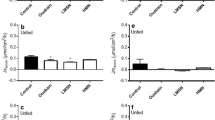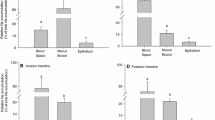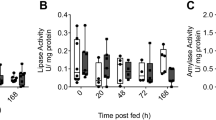Abstract
Digestion of dietary protein in teleosts results in high ammonia levels within the intestinal chyme that may reach concentrations that are many-fold greater than blood plasma levels. We used in vitro gut sac preparations of the ammoniotelic rainbow trout (Oncorhynchus mykiss) to investigate the role of the intestine in producing and transporting ammonia and urea, with specific focus on feeding versus fasting, and on responses to loading of the lumen with 2 mmol L−1 glutamine or 2 mmol L−1 ammonia. Feeding increased not only ammonia production and both mucosal and serosal fluxes, but also increased urea production and serosal fluxes. Elevated urea production was accompanied by an increase in arginase activity but minimal CPS III activity, suggesting that urea may be produced by direct arginolysis. The ammonia production and serosal fluxes increased in fasted preparations with glutamine loading, indicating an ability of the intestinal tissue to deaminate glutamine and perhaps use it as an energy source. However, there was little evidence of urea production or transport resulting from the presence of glutamine. Furthermore, the intestinal tissues did not appear to convert surplus ammonia to urea as a detoxification mechanism, as urea production and serosal flux rates decreased in fed preparations, with minimal changes in fasted preparations. Nevertheless, there was indirect evidence of detoxification by another pathway, as ammonia production rate decreased with ammonia loading in fed preparations. Overall, our study suggests that intestinal tissues of rainbow trout have the ability to produce urea and detoxify ammonia, likely via arginolysis.






Similar content being viewed by others
References
Alsop DH, Wood CM (1997) The interactive effects of feeding and exercise on oxygen consumption, swimming performance and protein usage in juvenile rainbow trout (Oncorhynchus mykiss). J Exp Biol 200:2337–2346
Anderson PM (1995) Urea cycle in fish: molecular and mitochondrial studies. In: Wood C, Shuttleworth TJ (eds) Fish physiology. Academic Press, New York, pp 57–83
Anderson PM (2001) Urea and glutamine synthesis: environmental influences on nitrogen excretion. In: Wright PA, Anderson PM (eds) Fish physiology. Academic Press, New York, pp 239–277
Anderson PM, Broderius MA, Fong KC et al (2002) Glutamine synthetase expression in liver, muscle, stomach and intestine of Bostrichthys sinensis in response to exposure to a high exogenous ammonia concentration. J Exp Biol 205:2053–2065
Bakke-McKellep AM, Nordrum S, Krogdahl Å, Buddington RK (2000) Absorption of glucose, amino acids, and dipeptides by the intestines of Atlantic salmon (Salmo salar L.). Fish Physiol Biochem 22:33–44. https://doi.org/10.1023/A:1007872929847
Ballantyne JS (2001) Amino acid metabolism. Fish Physiol 20:77–107. https://doi.org/10.1016/S1546-5098(01)20004-1
Braun MH, Steele SL, Perry SF (2009) The responses of zebrafish (Danio rerio) to high external ammonia and urea transporter inhibition: Nitrogen excretion and expression of rhesus glycoproteins and urea transporter proteins. J Exp Biol 212:3846–3856. https://doi.org/10.1242/jeb.034157
Brett JR, Zala CA (1975) Daily pattern of nitrogen excretion and oxygen consumption of sockeye salmon (Oncorhynchus nerka) under controlled conditions. J Fish Res Board Can. https://doi.org/10.1139/f75-285
Bucking C, Wood CM (2008) The alkaline tide and ammonia excretion after voluntary feeding in freshwater rainbow trout. J Exp Biol 211:2533–2541. https://doi.org/10.1242/jeb.015610
Bucking C, Wood CM (2012) Digestion of a single meal affects gene expression of ion and ammonia transporters and glutamine synthetase activity in the gastrointestinal tract of freshwater rainbow trout. J Comp Physiol B Biochem Syst Environ Physiol 182:341–350. https://doi.org/10.1007/s00360-011-0622-y
Bucking C, Landman MJ, Wood CM (2010) The role of the kidney in compensating the alkaline tide, electrolyte load, and fluid balance disturbance associated with feeding in the freshwater rainbow trout, Oncorhynchus mykiss. Comp Biochem Physiol A Mol Integr Physiol 156:74–83. https://doi.org/10.1016/j.cbpa.2009.12.021
Bucking C, Edwards SL, Tickle P et al (2013a) Immunohistochemical localization of urea and ammonia transporters in two confamilial fish species, the ureotelic gulf toadfish (Opsanus beta) and the ammoniotelic plainfin midshipman (Porichthys notatus). Cell Tissue Res 352:623–637. https://doi.org/10.1007/s00441-013-1591-0
Bucking C, LeMoine CM, Craig PM, Walsh PJ (2013b) Nitrogen metabolism of the intestine during digestion in a teleost fish, the plainfin midshipman (Porichthys notatus). J Exp Biol 216:2821–2832. https://doi.org/10.1242/jeb.081562
Chadwick TD, Wright PA (1999) Nitrogen excretion and expression of urea cycle enzymes in the Atlantic cod (Gadus morhua L.): a comparison of early life stages with adults. J Exp Biol 202:2653–2662
Collie NL, Ferraris RP (1995) Nutrient fluxes and regulation in fish intestine. Biochem Mol Biol Fishes 4:221–239. https://doi.org/10.1016/S1873-0140(06)80012-3
Cowey CB, Sargent JR (1972) Fish nutrition. Adv Mar Biol 10:383–494. https://doi.org/10.1016/S0065-2881(08)60419-8
Cvancara VA (1969) Comparative study of liver uricase activity in fresh-water teleosts. Comp Biochem Physiol 28:725–732. https://doi.org/10.1016/0010-406X(69)92104-5
Dépêche J, Gilles R, Daufresne S, Chiapello H (1979) Urea content and urea production via the ornithine-urea cycle pathway during the ontogenic development of two teleost fishes. Comp Biochem Physiol Part A Physiol 63:51–56. https://doi.org/10.1016/0300-9629(79)90626-1
Felskie AK, Anderson PM, Wright PA (1998) Expression and activity of carbamoyl phosphate synthetase III and ornithine urea cycle enzymes in various tissues of four fish species. Comp Biochem Physiol B Biochem Mol Biol 119:355–364. https://doi.org/10.1016/S0305-0491(97)00361-1
Goldstein L, Forster ROYP (1965) The role of uricolysis in the production of urea by fishes and other aquatic vertebrates. Comp Biochem Physiol 14:567–576
Julsrud EA, Walsh PJ, Anderson PM (1998) N-acetyl-l-glutamate and the urea cycle in gulf toadfish (Opsanus beta) and other fish. Arch Biochem Biophys 350:55–60. https://doi.org/10.1006/abbi.1997.0511
Kajimura M, Croke SJ, Glover CN, Wood CM (2004) Dogmas and controversies in the handling of nitrogenous wastes: The effect of feeding and fasting on the excretion of ammonia, urea and other nitrogenous waste products in rainbow trout. J Exp Biol 207:1993–2002. https://doi.org/10.1242/jeb.00901
Kajimura M, Walsh PJ, Mommsen TP, Wood CM (2006) The dogfish shark (Squalus acanthias) increases both hepatic and extrahepatic ornithine urea cycle enzyme activities for nitrogen conservation after feeding. Physiol Biochem Zool 79:602–613. https://doi.org/10.1086/501060
Karlsson A, Eliason EJ, Mydland LT et al (2006) Postprandial changes in plasma free amino acid levels obtained simultaneously from the hepatic portal vein and the dorsal aorta in rainbow trout (Oncorhynchus mykiss). J Exp Biol 209:4885–4894. https://doi.org/10.1242/jeb.02597
Kaushik SJ, Dabrowski KR, Dabrowska H et al (1983) Utilization of dietary urea in rainbow trout. Ann Nutr Metab 27:94–106. https://doi.org/10.1159/000176628
Kong H, Edberg DD, Korte JJ et al (1998) Nitrogen excretion and expression of carbamoyl-phosphate synthetase III activity and mRNA in extrahepatic tissues of largemouth bass (Micropterus salmoides). Arch Biochem Biophys 350:157–168. https://doi.org/10.1006/abbi.1997.0522
Korte JJ, Salo WL, Cabrera VM et al (1997) Expression of carbamoyl-phosphate synthetase III mRNA during the early stages of development and in muscle of adult rainbow trout (Oncorhynchus mykiss). J Biol Chem 272:6270–6277. https://doi.org/10.1074/jbc.272.10.6270
Lindley TE, Scheiderer CL, Walsh PJ et al (1999) Muscle as the primary site of urea cycle enzyme activity in an alkaline lake-adapted tilapia, Oreochromis alcalicus grahami. J Biol Chem 274:29858–29861. https://doi.org/10.1074/jbc.274.42.29858
Mommsen TP, Busby ER, Von Schalburg KR et al (2003) Glutamine synthetase in tilapia gastrointestinal tract: Zonation, cDNA and induction by cortisol. J Comp Physiol B Biochem Syst Environ Physiol 173:419–427. https://doi.org/10.1007/s00360-003-0350-z
Pelster B, Wood CM, Speers-Roesch B et al (2015) Gut transport characteristics in herbivorous and carnivorous serrasalmid fish from ion-poor Rio Negro water. J Comp Physiol B Biochem Syst Environ Physiol 185:225–241. https://doi.org/10.1007/s00360-014-0879-z
Rahmatullah M, Boyde TRC (1980) Improvements in the determination of urea using diacetyl monoxime; methods with and without deproteinisation. Clin Chim Acta 107:3–9. https://doi.org/10.1016/0009-8981(80)90407-6
Randall DJ, Wright PA (1987) Ammonia distribution and excretion in fish. Fish Physiol Biochem 3:107–120. https://doi.org/10.1007/BF02180412
Randall DJ, Wood CM, Perry SF et al (1989) Urea excretion as a strategy for survival in a fish living in a very alkaline environment. Nature 337:165–166. https://doi.org/10.1038/337165a0
Rubino JG, Zimmer AM, Wood CM (2014) An in vitro analysis of intestinal ammonia handling in fasted and fed freshwater rainbow trout (Oncorhynchus mykiss). J Comp Physiol B Biochem Syst Environ Physiol 184:91–105. https://doi.org/10.1007/s00360-013-0781-0
Rubino JG, Wilson JM, Wood CM (2019) An in vitro analysis of intestinal ammonia transport in fasted and fed freshwater rainbow trout: roles of NKCC, K+ channels, and Na+, K+ ATPase. J Comp Physiol B Biochem Syst Environ Physiol 189:549–566. https://doi.org/10.1007/s00360-019-01231-x
Schmidt-Nielsen B (1958) Urea excretion in mammals. Am Physiol Soc 38:139–168
Terjesen BF, Finn RN, Norberg B, Ronnestad I (2002) Kinetics and fates of ammonia, urea, and uric acid during oocyte maturation and ontogeny of the Atlantic halibut (Hippoglossus hippoglossus L.). Comp Biochem Physiol A Mol Integr Physiol 131:443–455. https://doi.org/10.1016/S1095-6433(01)00496-2
Turner LA, Bucking C (2019) The role of intestinal bacteria in the ammonia detoxification ability of teleost fish. J Exp Biol. https://doi.org/10.1242/jeb.209882
Wood CM, Perry SF, Wright PA et al (1989) Ammonia and urea dynamics in the Lake Magadi tilapia, a ureotelic teleost fish adapted to an extremely alkaline environment. Respir Physiol 77:1–20. https://doi.org/10.1016/0034-5687(89)90025-X
Wood CM, Hopkins TE, Hogstrand C, Walsh PJ (1995) Pulsatile urea excretion in the ureagenic toadfish Opsanus beta: an analysis of rates and routes. J Exp Biol 198:1729–17241
Wood CM, Nawata CM, Wilson JM et al (2013) Rh proteins and NH4+-activated NH4+-ATPase in the Magadi tilapia (Alcolapia grahami), a 100% ureotelic teleost fish. J Exp Biol 216:2998–3007. https://doi.org/10.1242/jeb.078634
Wood CM, Liew HJ, De Boeck G et al (2019) Nitrogen handling in the elasmobranch gut: a role for microbial urease. J Exp Biol. https://doi.org/10.1242/jeb.194787
Wright PA, Wood CM (2009) A new paradigm for ammonia excretion in aquatic animals: role of Rhesus (Rh) glycoproteins. J Exp Biol 212:2303–2312. https://doi.org/10.1242/jeb.023085
Wright PA, Felskie A, Anderson PM (1995) Induction of ornithine-urea cycle enzymes and nitrogen metabolism and excretion in rainbow trout (Oncorhynchus mykiss) during early life stages. J Exp Biol 198:127–135
Zimmer AM, Nawata CM, Wood CM (2010) Physiological and molecular analysis of the interactive effects of feeding and high environmental ammonia on branchial ammonia excretion and Na+ uptake in freshwater rainbow trout. J Comp Physiol B Biochem Syst Environ Physiol 180:1191–1204. https://doi.org/10.1007/s00360-010-0488-4
Zimmer AM, Wright PA, Wood CM (2017) Ammonia and urea handling by early life stages of fishes. J Exp Biol 220:3843–3855. https://doi.org/10.1242/jeb.140210
Funding
This work was supported by NSERC Discovery grants (NSERC RGPIN 473-2012 and RGPIN 03843-2017) to CMW, who was also supported by the Canada Research Chair Program (Award 203776).
Author information
Authors and Affiliations
Contributions
JS, JGR, and CMW: conceptualization, methodology, investigation. EHJ: formal analysis, writing—original draft preparation. EHJ, JS, JGR, and CMW: writing. All authors—review and editing.
Corresponding author
Ethics declarations
Conflict of interest
No conflict of interest, financial or otherwise, are declared by the authors.
Additional information
Communicated by B. Pelster.
Publisher's Note
Springer Nature remains neutral with regard to jurisdictional claims in published maps and institutional affiliations.
Rights and permissions
About this article
Cite this article
Jung, E.H., Smich, J., Rubino, J.G. et al. An in vitro study of urea and ammonia production and transport by the intestinal tract of fed and fasted rainbow trout: responses to luminal glutamine and ammonia loading. J Comp Physiol B 191, 273–287 (2021). https://doi.org/10.1007/s00360-020-01335-9
Received:
Revised:
Accepted:
Published:
Issue Date:
DOI: https://doi.org/10.1007/s00360-020-01335-9




